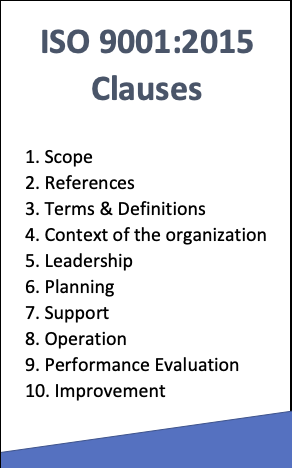In a recent article, we covered an introduction to ISO 9001.
Central to ISO 9001 are its key requirements, which outline the fundamental elements necessary for establishing and implementing a quality management system and then, in a systematic fashion, maintaining and continually improving it.
ISO 9001 entails ten clauses comprising both mandatory and non-mandatory requirements, which are critical for QMS compliance and efficiency.
9001: 2015 revision contains 10 clauses, 7 comprising the ‘mandatory’ requirements.
The clauses are designed to guide organizations in establishing robust quality management systems that align with ISO standards. From understanding organizational context to continual improvement, each clause serves a distinct purpose in enhancing organizational performance and customer satisfaction.
This article will explore the key requirements of ISO 9001 and their significance in driving quality management excellence within organizations.
What is ISO 9001
Let’s first remind ourselves what exactly is ISO 9001.
ISO 9001 is an internationally recognized standard for quality management systems (QMS).
Among its key benefits is that it assists organizations with a tried-and-true framework to provide a robust QMS, improve processes, enhance customer satisfaction, and achieve continual improvement.
ISO 9001 Key Requirements

1. Scope
The scope refers to the two foundations of quality management and what it sets out to achieve.
- Establish processes and systems to maintain uniformity in the production and delivery of an organization’s products and services.
- Enhancing customer satisfaction via conformity and continuous improvement.
2. References
According to Clause 2, the organization is required to create and upkeep a list of normative references.
3. Terms & Definitions
Terms and Definitions used for enhancing understanding of basic terms.
4. Context of the Organization
The first key requirement of ISO 9001 is to establish the context of the organization. This involves understanding both internal and external factors impacting the organization’s ability to achieve its quality objectives. Organizations must identify their stakeholders, including customers, suppliers, employees, and regulatory bodies, and determine their requirements and expectations.
5. Leadership
Leadership commitment is essential for the successful implementation of ISO 9001.
The organization’s leadership must demonstrate commitment to the quality management system by establishing quality policy and objectives, ensuring their alignment with the organization’s strategic direction, and actively supporting the implementation and continual improvement of the QMS.
6. Planning
ISO 9001 requires organizations to plan and establish objectives for their quality management system. This involves identifying risks and opportunities that may affect the organization’s ability to achieve its quality objectives and implementing actions to address them. Organizations must also plan the processes needed for the QMS and allocate resources accordingly.
7. Support
The support requirement of ISO 9001 emphasizes the importance of providing the necessary resources, competence, awareness, communication, and documented information to support the operation and effectiveness of the quality management system. This includes ensuring that personnel are competent to perform their tasks, providing appropriate infrastructure and work environment, and establishing effective communication channels.
8. Operation
The operation requirement of ISO 9001 covers the execution of planned processes, including the design, development and provision of products and services. It also includes the control of externally provided processes, products, and services. Organizations must ensure that their processes are carried out under controlled conditions and that any changes are managed effectively to maintain conformity to requirements.
9. Performance Evaluation
ISO 9001 requires organizations to monitor, measure, analyze, and evaluate the performance of their quality management system. This involves a data-driven approach to determine the effectiveness of processes, the achievement of quality objectives, and the satisfaction of customer requirements. Organizations must also conduct internal audits and management reviews to ensure the continual improvement of the QMS.
10. Improvement
The final essential requirement of ISO 9001 is to implement actions to address non-conformities and continually improve the effectiveness of the quality management system. This includes taking corrective actions to eliminate the causes of nonconformities, preventing their recurrence, and implementing preventive actions to minimize their causes and effects.
Summary
Understanding the key requirements of ISO 9001 is paramount for organizations seeking to enhance their quality management practices and achieve certification.
By adhering to the standard’s structured framework and leveraging training resources, organizations can confidently navigate the complexities of ISO 9001.
These essential requirements of ISO 9001 form the foundation for building a robust quality management system that enables organizations to consistently meet customer requirements, enhance customer satisfaction, and drive continual improvement.
By understanding and implementing these key requirements, organizations can establish a culture of quality excellence, improve operational efficiency, and achieve sustainable business success in today’s competitive marketplace.
Embracing a culture of continual improvement and compliance with ISO 9001 requirements will enhance organizational performance and foster customer satisfaction and long-term success.
